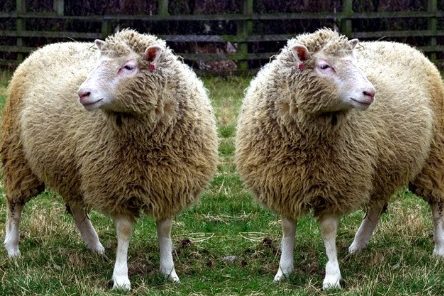
By: Muhammad Tegar K K
First Expert Livestock Seed Supervisor
Based on etymology, the term cloning originates from the Greek language, specifically from the words Klonus or Kloon which mean branch, shoot, bud, or graft. Essentially, cloning is the process of duplication (making an exact replica) of a living creature using the DNA code of that organism. Living beings produced through cloning are referred to as clones.
Development of Animal Cloning
Animal cloning has been around since the early 1900s, but successful examples of cloned animals were only achieved through the research of Wilmut et al in 1996, which demonstrated for the first time that cloning could be done in adult mammals (Hine, 2004). According to Budidaryono (2009), animal cloning began when American reproductive biology experts, Briggs and King, successfully cloned frogs in 1952 by transferring genetic material from an embryonic frog cell into an enucleated frog egg. In 1962, Gurdon transplanted the nucleus of a differentiated somatic frog intestine cell into an enucleated frog egg. The nucleus-containing egg then developed into a cloned frog (Arnold, 2009).
Further progress was made in 1967 when Mintz successfully transplanted embryonic somatic cells from blastula and morula stages into a rat's uterus, resulting in a cloned rat (Budidaryono, 2009). Since then, many researchers have reported successful cloning of animals using somatic cell nuclear transfer techniques. Some examples include a male calf named Gene, cloned by Infigen Inc. from a fetal cell in 1997, a goat named Mira cloned from embryonic cells by Genzyme Transgenic Corporation and Tufts University in 1998. In the same year, researchers from the University of Hawaii successfully cloned three generations of mice from cumulus cells. In 2000, the University of Teramo in Italy cloned a mouflon from adult cells, and a team from PPL Therapeutics produced several cloned pigs from adult cells named Millie, Christa, Alexis, Carrel, and Dotcom. CC, the first cloned female cat, was successfully cloned by Genetics Saving Clone in 2001. Two years later, Trans Ova Genetics and Advanced Cell Technologies produced the first cloned bull from adult cells. The first cloned deer and donkey were also achieved in 2003.
In 2004, two cats were cloned using chromatin transfer technology. These cats were named Tabouli and Baba Ganoush (Anonima, 2009). Arnold (2009) reported that in 2004, South Korean scientists produced several human embryo clones. They intended to use these cloned embryos to generate embryonic stem cells for disease treatment. In 2005, Seoul National University successfully produced the first cloned dog named Snuppy.
In November 2007, the world was surprised by Oregon scientists who claimed to have successfully cloned monkey embryos and extracted stem cells from them. This achievement was reported by Australian scientist Soukhrat Mitalipov from the Oregon National Primate Research Center in Portland (Rusda, 2004). According to Setiawan (2009), Mitalipov succeeded in producing embryonic stem cells using SCNT technology. He used skin cells as somatic donor cells taken from a 10-year-old male rhesus monkey and transferred them into enucleated egg cells. Mitalipov also managed to differentiate these embryonic stem cells into heart and neuron cells.
The production of cloned animals from various species by numerous laboratories demonstrates a strong desire to produce or clone animals with specific genotypes. Additionally, there is a demand for cloning nearly extinct, sterile, infertile, or deceased animals.
A May 2009 issue of National Geographic presented interesting news about scientists' efforts to resurrect the mammoth (Mammuthus primigenius), a giant furry elephant that once roamed the Arctic thousands of years ago. This was based on a complete mammoth calf specimen found in Siberia. The hope of reviving extinct species increased after Teruhiko Wakayama successfully cloned a mouse from frozen cells that had been preserved for two decades. Furthermore, the discovery made by Mitalipov and the success of Clonaid in producing the first human clone named Eve in 2002 demonstrate that cloning technology can be applied to humans. With this success, scientists were challenged to perform human cloning, both for reproductive purposes to create whole individuals and for therapeutic cloning to treat various diseases using stem cell therapy.
Benefits of Animal Cloning
According to Rusda (2004), the main benefits of cloning include the following:
- Advancing scientific knowledge: Cloning is beneficial for the development of biology, particularly in the fields of reproduction-embryology and differentiation.
- Developing and propagating superior breeds: Cloning has been used in embryo transfer for cattle, as well as in other livestock such as sheep and goats. By using nuclei from superior donors, the resulting clones can inherit those superior traits. The traits can be further enhanced when combined with transgenic techniques by introducing desired genes into the zygote nucleus, resulting in genetically improved clones.
- Diagnostic and therapeutic purposes: For instance, in cases where a couple is at risk of passing on a genetic disease like thalassemia major, cloning can be employed. Cloning embryos at the blastomere stage allows for genetic testing, and if a blastomere is found to carry the disease, therapy can be applied to the healthy blastomere before developing into a blastocyst. Another application is in vitro cultivation of stem cells to create organs or tissues for replacing damaged ones.
- Aiding infertile couples: Cloning technology can assist infertile couples in having offspring. For medically recognized infertility, cloning can be revolutionary. Individuals who cannot produce eggs or sperm can benefit, as they only need a small number of somatic cells from any source to create offspring with genetic contributions from one spouse or both.
Animal Cloning Techniques
In general, cloning can be accomplished through embryo splitting, blastomere dispersal, and nuclear transfer, also known as somatic cell nuclear transfer (SCNT).
- Embryo Splitting: This technique is used to multiply animals with desired genetic traits. The embryo is split into two halves, and each half develops into a separate individual. This method was applied to produce several identical calves, lambs, and piglets, making it possible to create more offspring from females that have good genetic potential.
- Blastomere Dispersal: In this technique, cells from early embryos (blastomeres) are isolated and allowed to develop into separate embryos. This method has been used to produce identical quadruplets in cattle and triplets in mice.
- Nuclear Transfer: This technique involves transferring the nucleus of a somatic cell into an enucleated egg cell. This nucleus contains the genetic material necessary to develop into a new individual. The egg, now containing the nucleus, is stimulated to divide and develop into an embryo. The embryo is then transferred to the uterus of a surrogate mother, where it develops until birth. The most famous cloned animal, Dolly the sheep, was produced using this technique. The process involves the following steps: removal of the egg nucleus, insertion of a nucleus from a somatic cell, development stimulation, and embryo transfer. Although this technique has great potential, it has a low success rate and requires extensive optimization.
Conclusion
In conclusion, animal cloning has come a long way since its early days, with numerous successful examples of cloned animals from various species. The technology offers benefits in terms of advancing scientific knowledge, improving breeds, diagnostic and therapeutic purposes, and aiding infertile couples. Various cloning techniques like embryo splitting, blastomere dispersal, and nuclear transfer have been developed and utilized to achieve these goals. While there are challenges and ethical considerations surrounding cloning, its potential impact on various fields is undeniable.
Disclaimer: This article is the result of personal studies and is not a reference source in any scientific publication.



